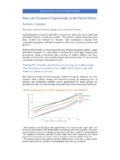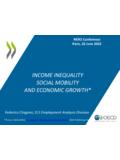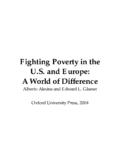Transcription of Mobility Report Cards: The Role of Colleges in ...
1 Mobility Report Cards: The Role of Colleges in Intergenerational Mobility Raj Chetty, Stanford University and NBERJohn N. Friedman, Brown University and NBERE mmanuel Saez, UC-Berkeley and NBERN icholas Turner, US TreasuryDanny Yagan, UC-Berkeley and NBERJuly 2017 AbstractWe characterize intergenerational income Mobility at each college in the United States usingdata for over 30 million college students from 1999-2013. We document four results. First,access to Colleges varies greatly by parent income . For example, children whose parents arein the top 1% of the income distribution are 77 times more likely to attend an Ivy Leaguecollege than those whose parents are in the bottom income quintile.
2 Second, children from low-and high- income families have similar earnings outcomes conditional on the college they attend,indicating that low- income students are not mismatched at selective Colleges . Third, rates ofupward Mobility the fraction of students who come from families in the bottom income quintileandreach the top quintile differ substantially across Colleges because low- income access variessignificantly across Colleges with similar earnings outcomes. Rates of bottom-to-top quintilemobility are highest at certain mid-tier public universities, such as the City University of NewYork and California State Colleges .
3 Rates of upper-tail (bottom quintile to top 1%) Mobility arehighest at elite Colleges , such as Ivy League universities. Fourth, the fraction of students fromlow- income families did not change substantially between 2000-2011 at elite private Colleges , butfell sharply at Colleges with the highest rates of bottom-to-top-quintile Mobility . Although ourdescriptive analysis does not identify Colleges causal effects on students outcomes, the publiclyavailable statistics constructed here highlight Colleges that deserve further study as potentialengines of upward Mobility .
4 The opinions expressed in this paper are those of the authors alone and do not necessarily reflect the views of theInternal Revenue Service or the Treasury Department. This work was conducted under IRS contract TIRNO-16-E-00013 and reviewed by the Office of Tax Analysis at the Treasury. We thank Joseph Altonji, David Deming,Lawrence Katz, Eric Hanushek, David Lee, Richard Levin, Sean Reardon, and numerous seminar participants forhelpful comments; Trevor Bakker, Kaveh Danesh, Niklas Flamang, Robert Fluegge, Jamie Fogel, Benjamin Goldman,Sam Karlin, Carl McPherson, Benjamin Scuderi, Priyanka Shende, and our other pre-doctoral fellows for outstandingresearch assistance; and especially Adam Looney for supporting this project.
5 Chetty, Friedman, Saez, and Yaganacknowledge funding from the Russell Sage Foundation, the Bill and Melinda Gates Foundation, the Robert WoodJohnson Foundation, the Center for Equitable Growth at UC-Berkeley, the Washington Center for Equitable Growth,the UC Davis Center for Poverty Research, Stanford University, the Alfred P. Sloan Foundation, and the Laura andJohn Arnold IntroductionHigher education is widely viewed as a pathway to upward income Mobility . However, inequalityin access to Colleges particularly those that offer the best chances of success could limit or evenreverse Colleges ability to promote intergenerational Mobility , especially since college attendancerates differ greatly by parental income (Chetty et al.)
6 2014). Which Colleges in America contributethe most to intergenerational income Mobility ? How can we increase access to such Colleges forchildren from low- income families?We take a step toward answering these questions by using administrative data covering allcollege students from 1999-2013 to construct publicly availablemobility Report cards statisticson students earnings outcomes and their parents incomes for each college in de-identified data from federal income tax returns and the Department of Education to obtaininformation on college attendance, students earnings in their early thirties, and their parents household our baseline analysis.
7 We focus on children born between 1980 and 1982 the oldest children whom we can reliably link to parents and assign children to Colleges based onthe college they attend most between the ages of 19 and 22. We then show that our results arerobust to a range of alternative specifications, such as measuring children s incomes at the householdinstead of individual level, using alternative definitions of college attendance, and adjusting fordifferences in local costs of these college-level Mobility Report cards, we document four sets of descriptive results thatshed light on how Colleges mediate intergenerational Mobility in the , access to Colleges varies substantially across the income distribution.
8 Among Ivy-Plus Colleges (the eight Ivy League Colleges , University of Chicago, Stanford, MIT, and Duke), morestudents come from families in the top 1% of the income distribution ( ) than the bottomhalf of the income distribution ( ). Only of students come from the bottom quintileof the income distribution at Ivy-Plus Colleges . As a result, children from families in the top 1%are 77 times more likely to attend an Ivy-Plus college compared to the children from families inthe bottom broadly, looking across all Colleges , the degree of income segregation1 Our analysis builds upon the data used to construct the Department of Education s College Scorecard (2015)by including all students (not just those receiving federal student aid)
9 , fully characterizing the joint distribution ofparent and child income , and examining changes over measure children s earnings between the ages of 32 and 34; we show that children s percentile ranks in theearnings distribution stabilize by age 32 at all findings support the conclusions of prior research documenting that elite private Colleges have a large shareof students from affluent families ( , Bowen and Bok 1998; Pallais and Turner 2006; Hill et al. 2011; Hoxby andAvery 2013). The data we use here permit a more granular analysis than was feasible in those studies, allowing us1across Colleges is comparable to the degree of income segregation across neighborhoods in theaverage American city.
10 These findings challenge the common perception that Colleges foster greaterinteraction between children from diverse socioeconomic backgrounds than the environments inwhich they grow , children from low- and high- income families have very similar earnings outcomes con-ditional on the college they attend. In the nation as a whole, children from the highest-incomefamilies end up 30 percentiles higher in the earnings distribution on average than those from thelowest- income families. In contrast, among students attending a given elite college (defined as oneof the Colleges in Tier 1 of Barron s 2009 ranking of selectivity), the gap between students from thehighest- and lowest- income families is only percentiles, 76% smaller than the national in outcomes at lower-ranked Colleges are relatively small as small gap in earnings outcomes between students from high- vs.





